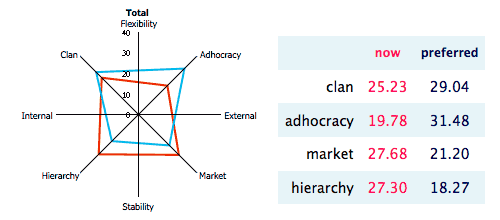
The Organizational Culture Assessment Instrument (OCAI) is a tool developed by Cameron and Quinn in 2006, to help organizations assess and understand their current culture and desired culture. OCAI is a powerful tool that can help organizations identify their current culture, understand its strengths and weaknesses, and make changes to improve performance.
The OCAI consists of two parts: the current culture profile and the desired culture profile. The current culture profile assesses the existing culture of an organization based on four different cultural types:
- Clan
- Adhocracy
- Market
- Hierarchy
Clan culture is characterized by a strong sense of family and community, Adhocracy culture is characterized by a high degree of autonomy and experimentation, Market culture is characterized by a strong focus on competition and results, and Hierarchy culture is characterized by a strong emphasis on rules and procedures.
The desired culture profile, on the other hand, assesses the culture an organization hopes to achieve in the future. It also uses the four cultural types, but it is based on the organization's goals and objectives, rather than its current state. Organizations can use the OCAI to compare the two profiles and identify any gaps between them.

The OCAI is a user-friendly, online survey that is easy to administer and can be completed by employees at all levels of the organization. The survey is divided into five sections:
- Background information
- Current culture
- Desired culture
- Gap analysis
- Action planning
It takes about 20-30 minutes to complete and can be distributed to large groups of employees for better results.
One of the strengths of OCAI is that it provides organizations with a detailed and objective analysis of their culture, which can help leaders to make informed decisions about how to improve it. It also gives employees a voice in shaping the culture of their organization, and can foster a sense of ownership and engagement.
Another strength of OCAI is its versatility. OCAI can be used in organizations of all sizes and industries, and it can be used for both for-profit and non-profit organizations. It is also available in multiple languages, making it accessible to organizations around the world.
Despite the benefits of OCAI, it is important to keep in mind that culture change is a complex and ongoing process. The OCAI can provide valuable insights, but organizations need to be prepared to invest time and resources into implementing changes based on the results. Additionally, OCAI should be conducted regularly (at least annually) to ensure that the culture of the organization stays aligned with its goals and objectives, and changes as per the need of the company.
The tool is minimized into thinking it is simply used to label an organization as either Clan, Adhocracy, Market or Hierarchical, and that is not the intention of the tool. Although when coaches are asked to describe their organizational culture, they typically use descriptors that are found in the definition of Clan, Adhocracy, Market or Hierarchy culture types. The power in the tool is about the dimensions that help describe the culture types. Leaders should utilize the tools results to assess a cultural gap.
The tools has six dimensions that are broken into two interaction patterns (…leadership style & management of employees), two organizational direction indicators (…strategic direction & criteria of success) and two basic assumptions about organizational life (…dominant characteristics & organization glue).
OCAI is also used by agile coaches to assist the organization in understanding and improving their culture. It's a great way for organizations to identify areas where they can make changes to better align with their goals and objectives and to focus on performance improvement overall.
If you want to implement OCAI in your organization, it's important to keep in mind that it should be used in conjunction with other methods, such as interviews, focus groups, and workshops to get a more holistic understanding of the culture and to bring real change to the organization. You could even identify that there are sub-cultures across business units that are different than the organization's identified holistic culture. Jeff DeGraff elaborates on a tool used in conjunction called the Competing Values Framework (the image at the top of the blog post). This helps to codify the culture in a more tangible way to leaders and team members.
-- "It's a mistake to leave culture to evolve on its own. As a leader and manager you really need to link culture to the bigger picture" - Cameron & Quinn
Come and learns some great tools, tricks, and tips on how to help your teams and your organization.